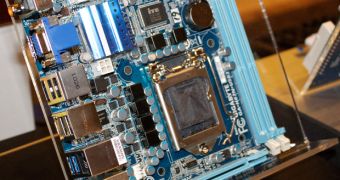The integrated design and low power consumption makes Sandy Bridge particularly well suited for being deployed in mini-ITX motherboards, so Gigabyte is planning not just one, but two such models, one based on the H67 chipset and the other on P67.
First in line is the GA-H67N-USB3 that is developed as a successor for the highly popular GA-H55N-USB3.
Just like its predecessor, the H67N-USB3 features two regular-sized DDR3 memory slots and a PCI Express x16 slot, making it an ideal option for users that want to build a compact LAN party gaming PC.
The board is also packed with four SATA ports, two of them being of the 6Gbps variety, an additional eSATA connector being placed on the motherboard's back panel.
This is accompanied by two USB 3.0 ports, a slew of video output options including dual HDMI and D-SUB, a Gigabit Ethernet port and a wide selection of digital and analog audio ports.
However, there's once catch if you decide to go for the GA-H67N-USB3 as Intel has disabled CPU overclocking in the H67 chipset.
For this reason, Gigabyte has started developing a P67 model that will use the same feature set as the H67N-USB3 minus the integrated graphics support.
Users will be, however, able to adjust the Sandy Bridge CPU multiplier, Gigabyte effectively allowing for processor overclocking.
According to the Tech Report website, these are all the details available for, but the board is expected to land at the end of the month.
Users that want to get integrated graphics support as well as overclocking capabilities will have to expect until the second quarter of 2011 when Intel plans to release the Z68 chipset.
This will add the flexible display interface (FDI) required in order to drive the video signal form the processors integrated graphics core to the video outputs while also keeping P67 overclocking support.
The first Z68 boards already started to make their appearance online, both Mitac and MSI showcasing such products.

 14 DAY TRIAL //
14 DAY TRIAL //